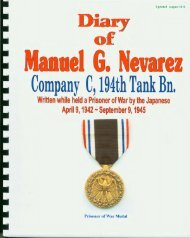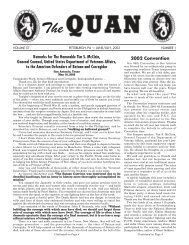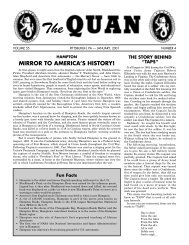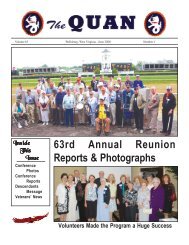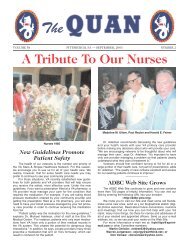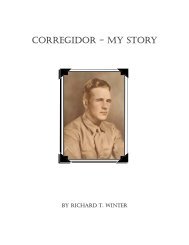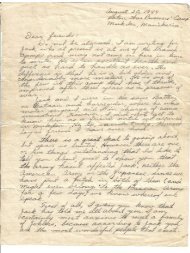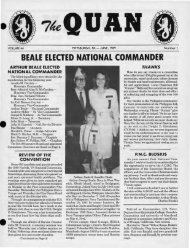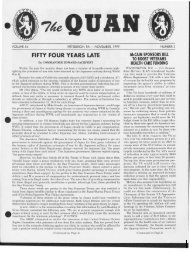Ferron Edwin Cummins - Philippine Defenders Main
Ferron Edwin Cummins - Philippine Defenders Main
Ferron Edwin Cummins - Philippine Defenders Main
Create successful ePaper yourself
Turn your PDF publications into a flip-book with our unique Google optimized e-Paper software.
THIS IS MY STORY<br />
1937<br />
High School<br />
Events and Circumstances<br />
From 1937 to 1946<br />
By: <strong>Ferron</strong> <strong>Edwin</strong> <strong>Cummins</strong><br />
Prepared: 1 February 1990<br />
1944<br />
Prisoner of War<br />
1946<br />
S/Sgt <strong>Ferron</strong> E. <strong>Cummins</strong>
THlS IS MY STORY<br />
Events and Circumstances from 1937 to 1946<br />
By: <strong>Ferron</strong> <strong>Edwin</strong> <strong>Cummins</strong><br />
Prepared: February 1990<br />
I graduated from higb scbool in Lake Artbur, New Mexico in May 1937 and left<br />
almost immediately for Tyler, Texas where my Uncle E. L. Hinton had arranged (or<br />
a scholarship to Tyler Commercial College. With my business school credentials I<br />
came borne in t 938 and finally secured a job as a teller/bookkeeper at the First<br />
National Bank in Hagerman, New Mexico.<br />
In 1940 war and rumors of war and the anticipated Draft Board notice inviting me<br />
into tbe Army made my life a little unsettled. My brother, Gurvis was working in<br />
Flagstaff, Arizona and the Draft Board was breathing down his neck so, he decided<br />
to enlist in the Army Air Corp. To eliminate the anxiety of waiting for my draft<br />
notice, I decided to go to Flagstaff where, 8 Novembcr 1940, Gurvis and I enlisted in<br />
the Army Air Corps. This was a commitment of one year, after which we intended<br />
to settle down to the task of making our first million.<br />
We were sent to Brooks Field, San Antonio, Texas, for basic training. When we<br />
returned from Christmas leave at home we brought my 1934 Chevrolet coupe back<br />
with us. Our pay at that time was S18.00 a month with a small deduction for the<br />
Old Soldiers Home. With that income we decided we could afford payments of<br />
SIO.OO or S12.00 a month on a new car. A light blue 1940 Chevrolet convertible at<br />
Smith Chevrolet on Broadway, in San Antonio, with 658 miles on the speedometer,<br />
proved to be the car we couldn't live without. I sold that car in 1947 and still think it<br />
was the most wonderful car ever made.<br />
After Christmas we were transferred to Kelly Field, still in San Antonio, where we<br />
dismantled buildings and cut bridle paths for the cavalry at what is now LackJand<br />
AFR. [n February 1941 we received orders to report to Hamilton Field, San Rafael,<br />
California (just north of San Francisco). Gurvis had to travel by troop train and r<br />
was permitted to drive our car. (I guess tbat was my reward for being two years<br />
older). Regulations at tbat time permitted only the owner of a vebicle to transport it<br />
to the next duty station. We showed the First Sergeant the car title indicating both<br />
<strong>Ferron</strong> E. and Gurvis L. <strong>Cummins</strong> as owners but young airmen that we were, we<br />
didn't convince him and we traveled separately. Gurvis reminds me he got more<br />
than his share of K.P. duty on tbat troop train ride while r was having a wonderful<br />
cross country drive.<br />
Gurvis was already assigned to the 70 lh Pursuit Squadron when I got to Hamilton<br />
Field and that separated us because,1 was assigned to the 34 th Pursuit Squadron.<br />
Both squadrons were under the 3S lh Pursuit Interceptor Group. From February to<br />
November we performed our assigned duties. I was an Operations Clerk and
Gurvis was an Instrument Technician. I received orden to depart I November 1941<br />
and Gurvis was to depart 20 November for "Project Plum" which was the<br />
<strong>Philippine</strong> Islands but we didn't know that at the time.<br />
Shortly after Gurvis and I arrived at Hamilton Field we signed up for pilot training<br />
like all other patriotic, red-blooded American young men were doing. f left for the<br />
<strong>Philippine</strong> Island, November I, and a few days later our Pilot Training orders came<br />
through. Gurvis was removed from his scheduled, 20 November, shipment and<br />
went to undergraduate pilot training and ultimately became a transport pilot. I<br />
didn't know until after the war that Gurvis wasn't somewhere in tbe <strong>Philippine</strong>s<br />
with me.<br />
The trip to the <strong>Philippine</strong>s was aboard the U.S.S. Coolidge, a lUxury liner that had<br />
not yet been converted to a troop carrier. It was elegantly outfitted, complete with a<br />
band, fine cbina and silver, lovely chandeliers and beautiful furniture. Of course I<br />
was a lowly corporal, a two striper, and was not privilege to some of these luxuries<br />
but it was nice. Aboard the U.S.S. Coolidge were members of the 341h Pursuit<br />
Squadron, tbe 21'1 Pursuit Squadron and tbe 27 1h Bomb Group.<br />
The voyage was uneventrul except for an enjoyable day in Honolulu. We docked at<br />
Pier 7 in Manila, <strong>Philippine</strong> Islands, 20 November 1941. I didn't have much time to<br />
get acquainted with my sew surroundings because, the Japanese started bombing us<br />
on 8 December, after they finished with their destruction of Pearl Harbor.<br />
Nichols Field was my first brief home in Manila. We were housed two or three days<br />
in tents and then assigned to barracks while we unloaded, unpacked and assembled<br />
our equipment and cargo. However, my personal hold-baggage never did catch up<br />
with me - I wonder where it eoded up? When we were assigned to a harracks we<br />
had a houseboy who did our laundry, shined our shoes, cleaned our area, ctc. This<br />
was sheer lUXUry that unfortunately didn't last very long. While we were at Nichols<br />
Field I received one pass and went into Manila with several of tbe guys to check it<br />
out. We looked around, ate at a nice restaurant (I had frog legs) and then took a<br />
carameta ride back to Nichols Field. That was my only peacetime look at Manila -<br />
a big adventure - and J wasn't too impressed.<br />
About 3 or 4 December we moved down to Del Cannen Field, on the old Dcl<br />
Carmen sugar plantation. We set up operations and my primary duty was manning<br />
the radio. Early the morning of December 8 we saw Japanese airplanes and heard<br />
that Pearl Harbor had been bombed. It didn't take long to learn what war was aU<br />
about. On 9 December our airplanes were up and we witnessed "dog fights" with<br />
the Japanese Zeros. One of our pilots, Lt. Page, had his airplane sbot up badly and<br />
I recall him landing the damaged airplane, jumping out and saying, "I want another<br />
plane!" That was the attitude of most of the men, very anxious to stop the invading<br />
forces. We were assigned P-35 aircraft with radial engines and Swedish<br />
instruments. Our Pilots were checked out in P-40 aircraft with Allison in-line<br />
1
engines. Getting acquainted with the P-35 aircraft in the early stages of the war was<br />
interesting and in some instances disastrous.<br />
The airfield, at Del Carmen, bad been made by bulldozing out through the sugar<br />
came field and then the ground covered with heavy, dark molasses. When it dried it<br />
made a good hard surface. The molasses was dispensed from a big oil tank car<br />
parked near the airfield. Japanese pilots kept strafing the field and particularly<br />
that tank car. You could almost see the Japanese pilots scratching their heads and<br />
wondering why that oil tank car wouldn't blow-up. Incidentally we didn't lose<br />
much molasses because sharpened bamboo sticks were driven into each hole as tbe<br />
invading plane passed on.<br />
There was a large, dense mango tree growing in a fairly good-sized sinkhole. It<br />
made an ideal place to rest and relax when time and conditions would permit. One<br />
day most of the ground personnel were eating lunch under the tree when the<br />
Japanese fighters came for their bomb and target practice. They really did a good<br />
job bombing and strafing the field but fortunately for us they missed the mango<br />
tree. A strategically positioned mortar in the center of that tree would have wiped<br />
out most of the ground personnel in one fly-over.<br />
Christmas dinner, 1941, at Del Carmen Sugar Central Headquarters was a<br />
wonderful meal complete with turkey and dressing and all the trimmings. But that<br />
was tbe last really good meal we would have for nearly four years. That afternoon<br />
we loaded our trucks and headed for the airfield at Orani, down on Bataan<br />
Peninsula, where we set up our headquarters in a school building. The Japs<br />
bombed and strafed the bridge at Orani and we were really too close. But fortunate<br />
they didn't wipe out the bridge and we continued to use it. At Orani I recall one<br />
squadron party with lots of beer iced down in washtubs. I didn't like beer at that<br />
time so it was just a good social gathering for me.<br />
After a few days, which would have been early January, we moved farther down on<br />
Bataan Peninsula. The 34 th Pursuit Squadron was primarily assigned to defend<br />
Aglaloma Points were the Aglaloma River empties into the China Sea.<br />
Many of the events for the duration of the war, tbe troop surrender, the Death<br />
March and my prison camp internment are vivid in my mind but, others are foggy<br />
and the time elements and sequence of events become confusing to me. The rest of<br />
my comments are not necessarily in chronological order, but I have identified dates<br />
or linked events where my memory will permit.<br />
From Orani we went on short, or reduced, food rations. First it was half our daily<br />
ration, then one-fourth ration and by April, just before the surrender, we were on<br />
one tenth our daily ration. Sgt Hardy, our Mess Sergeant, had made two trips to<br />
Stotzenburg to get food supplies. We had begun to bury food for later use and to<br />
keep the Japanese from getting it. But our food supply was depleting fast. On the<br />
J
Surrender was something that American troops did not do so it was a time of<br />
dejection, confusion and turmoil. We were told to take the bolts, or firing pins, out<br />
of our riffles and stack them in a designated place. We received two "e" rations of<br />
food, climbed onto trucks and headed for Marvels, a distance of about 12<br />
kilometers. We were stopped frequently and searched as the Japanese started<br />
relieving us of our personal items. 1 had two watches and a penknife that I had<br />
stored in the Squadron safe aod retrieved them when we were told to surrender. I<br />
lost the watches during one of the first searches - the Japanese really liked<br />
wristwatches.<br />
The first night as a prisoner I was aboard a truck, r had to relieve myself and the<br />
Jap guard let me. It is surprising to me, considering the treatment we received<br />
later, but I talked the guard into letting me sleep on tbe ground tbe rest of the night<br />
because the truck was over crowded. The next morning, Sergeant Hardy, our Mess<br />
Sergeant, collected all the available food and made a very good stew - the last tasty<br />
food for quite a while.<br />
Out on "Clay Hill", near Mariveles, as we were assembled for the infamous "Death<br />
March", we were placed in a kneeling position, searched again and left sitting in the<br />
hot tropical sun for about six hours witbout food or water.<br />
Word passed througb the ranks that tbe Japs were looking for knives and I had so<br />
far concealed my gold penknife. By this time my better judgment told me to get rid<br />
of it as soon as possible. I buried it in the field right where we were standing. Later,<br />
we were alerted to the fact the Japanese were looking for any items marked, "Made<br />
in Japan". They believed such items had to have been taken from some dead<br />
Japanese soldier. Most of our combs, brushes, tooth brushed, etc. at that time, were<br />
marked "Made in Japan". I got rid of my few possessions and didn't receive any<br />
undue punishment for having "Made in Japan" items like some of tbe others did.<br />
You could not reason with the Japanese and their erratic behavior got worse.<br />
The Squadron personnel tried to stay together as much as possible. We formed sixman<br />
buddy teams in an effort to stay together and belp each other. My buddy team<br />
members were E.J. Batson, Larry Coben, Travis Dillon, Bud Ellsworth and Red<br />
Fipps.<br />
Before we left Mariveles, Travis Dillon got a can of corned beef hash from a<br />
Filipino. It was good but, entirely too salty without adequate water and water was a<br />
scarce item. Later, I saw a FilipiDo Woman with a tin cao filled with rice cakes and<br />
cakes of pony sugar. Pony sugar was smaU cakes of solid dark sugar usuaUy fed to<br />
their ponies. I was able to pay her S)O.OO for the can and its contents without the<br />
Jap guards seeing me. We divided the contents among the six of us in my buddy<br />
team and kept the caD. It proved to be a valuabJe item to scoop up water from the<br />
artesian wells along tbe route when we could get close enough to a weD and a guard<br />
wasn't too close.
I think it was the second day of the "March", we were herded off the road at Bataan<br />
airstrip. We were allowed to sit but the guards made sure we circled four 155mB<br />
artillery gUDS. The gUDS were firing across the bay at Corregidor. When the<br />
American forces on Corregidor returned the fire their first mortar went over us and<br />
the second mortar was short. The third mortar was on target and wiped out the<br />
artillery guns. It would have killed most of the prisoners and guards but, without<br />
any orders, all tbe prisoners and the guards had scattered to safety.<br />
The "Death March", for me, started on 10 April ]942 at Mariveles and ended at<br />
Camp O'Donnell on 2] April ]942. We marched from Mariveles to San Fernando,<br />
a distance of about 120 kilometers, were placed in narrow gauge boxcars for a ride<br />
from San Fernando to Capus and then walked approximately nine more miles to<br />
Camp O'Donnell.<br />
When I enlisted in the Army Air Corps I was strong, healthy and weighed<br />
approximately 140 pounds. During high school I had heen very athletic and<br />
remained active and in excellent physical condition. I was one of the healthier<br />
individuals, weighing approximately 130 pounds when the "Death March" began. I<br />
was strong enough to help some of my buddies and friends who were weaker. I<br />
received one deep bayonet wound on my right leg during the "March" when a Jap<br />
guard discovered I was helping a friend. I had two close friends removed my arms<br />
and shot immediately. Another close friend went insane and dived head first from a<br />
bridge to a dry rock bed below. During the "March" I passed blood from my<br />
kidneys for about a week.. Approximately thirteen thousand Americans started the<br />
" Death March" and about eight thousand survived the ordeal and reached San<br />
Fernando.<br />
A typical day on the "March" was endless marching, a few hours toward San<br />
Fernando and then turning around and marching back a few hours. Monotonous,<br />
one foot in front of the other. Always hungry and thinty, dejected and depressed.<br />
Trying to stay alert for the irate behavior of the guards and trying to help ailing and<br />
weary comrades. On the entire "March" I recaU receiving only one rice ball and<br />
that was at San Fernando. After the first day or two we were unable to get food<br />
from tbe Filipinos even though they constantly wanted to give us food. The<br />
Japanese were determined that we would receive very little food and water. At<br />
Orani some of the men were fed a small ration but the supply was inadequate and<br />
was gone before I got tbere. I didn't see any rice mucb less anything else.<br />
All Japanese guards were not mean and inhumane in their treatment but the<br />
humane guards were definitely in the minority. Some bumane guards showed their<br />
compassion by letting a group of us cleans ounelves and cool off in a river. I think<br />
it was near Orani, I took advantage of the opportunity and removed my shoes and<br />
went into the water clothes and aU. It was a good refreshing cleansing of body,<br />
c10tbes and soul, as well as an opportunity to fill our canteens.
About ten kilometers out of San Fernando we had a start marching double time.<br />
That was pretty rougb since we were hungry, thirsty, tired and sick. About this<br />
time E.J. (Shorty) Batson got clobbered by a drunk Jap. Tbe Jap came out of a bar<br />
and hit Sborty on tbe head, probably because he was the shortest person around<br />
and more nearly the Japs size. Shorty was knocked out but we were able to carry<br />
him the rest of the way into the enclosure (fenced in yard) at San Fernando. I don't<br />
like to tell what we did to that Jap - he didn't fair very well - and thankfully we<br />
didn't get caught, disposing of the Jap or carrying Shorty.<br />
[n San Fernando I lost my Schaeffer pen and pencil set. I was trying to buy some<br />
boiled eggs from a Filipino and got caugbt. Fortunately the guard was interested in<br />
the pen and pencil and I bribed him with the set but, of coune, I didn't get the<br />
boiled eggs. That pen and pencil had my name engraved in gold.<br />
We were in the fenced enclosure at San Fernando about two day and nights then,<br />
herded into narrow gauge boxcars. About sixty men would have been too many in<br />
each car and they forced, like prodding cattle, about 125 men into each car. They<br />
closed the door and locked it from tbe outside. With the tropical heat, no<br />
ventilation, standing room only and tropical diseases rampant, tbe journey was<br />
unbelievable. When the boxcar doors were opened at Capus tbere were a number<br />
in my car that bad not survived the trip but so many had already died it wasn't<br />
surprising.<br />
After we were released from the boxcars the additional nine-mile walk from Capus<br />
to our first prison camp, Camp O'Donnell, was just an extension of the inhumane<br />
treatment of the "Death March" on Bataan. I think I arrived at Camp O'Donnell<br />
on, 21 April, my sister's birthday. I had lost weight due to the food shortage prior to<br />
the "Surrender" and the lack of food furnished on the "Deatb March". But, I bad<br />
escaped the malaria, dysentery and other devastating ailment that had plagued so<br />
many and caused many to die on the "March". However, before I left Camp<br />
O'Donnell, the ravages of these ailments caught up with me.<br />
At Camp O'Donnell we were bothered very little except when some Japanese guard<br />
took a notion he wanted to be a big shot. He would work over several of us and we<br />
could show no resistance because, if we harmed a guard in any way, ten men were<br />
punisbed and usually killed. Our days were occupied burying our dead and<br />
attempting to patch up our wounds and recover from our illnesses. One of the first<br />
things we learned was to conceal all of our emotions.<br />
The Japanese reasoned that slow starvation would make us too weak to attempt to<br />
escape or resist authority. To further insure our lack of resistance, tbe Japanese<br />
divided us into groups of ten men with the ranking NCO in charge. Our duty was to<br />
assure each maD was familiar with the camp rules. The main rule being, "If one<br />
prisoner escapes, the remaining nine will be sbot". Recaptured escapees were<br />
paraded around tbe camp for some twenty-four boun and then used for bayonet<br />
7
practice. Each prisoner was punished for all crimes committed by the other nine.<br />
was NCOIC of a squad of men during my entire internment.<br />
At Camp O'Donnell I was assigned to work in the kitchen as a cook. But after<br />
about three weeks of working close to the fires and out in the hot sun, I was<br />
suddenly stricken with what was diagnosed as a sunstroke. This completely<br />
incapacitated me for quite a while. During this same period I contracted dysentery,<br />
malaria, dingy fever, wet and dry beriberi and yellow jaundice.<br />
My malaria attacks would finally subside thanks to my good friend San Bass, who<br />
got some quinine and shared it with me. The wet and dry beriberi were perplexing<br />
and painful ailments. Dry beriberi affected the bone and was terribly painful. Wet<br />
beriberi caused edema - swelling that stared in the feet and legs then went to the<br />
upper extremities. When tbe swelling reached the heart it was usually fatal. It<br />
seemed that the men with wet beriberi who laid down never did get up. With this<br />
observation I resolved to never lie down when my wet beriberi was bad. Many<br />
nights I would tie myself to a pole in a sitting position hoping to keep the severe<br />
swelling from reaching my heart and lungs. It may not have belped but I was<br />
determined to not give up. My legs swelled to at least twice their nonnal size. I got<br />
so weak I had to be helped to the latrine facility (an open ditcb). I weighed about 75<br />
to 80 pounds. Malnutrition caused these ailments with the exception of maybe<br />
malaria and dysentery. I refused to go to the "hospital" or "zero ward"-those two<br />
words translated to death and I wasn't ready for that.<br />
At Cabanatuan Prisoner of War Camp I wasn't mistreated to aoy great detail. Still<br />
suffering from dysentery, beriberi and malaria, a new ailment developed. My<br />
breasts enlarged to an embarrassing size. They became extremely hard and<br />
excreted a milky liquid for several months. Travis Dillon died here - he went<br />
completely blind Shortly before he died. The other (our men of my original six-man<br />
buddy team returned home.<br />
As healthier pri.soners were moved to Cabanatuan Prison Camp, I was left at Camp<br />
O'Donnell, along with hundreds of others, to die. Most of the others did die. 1 was<br />
determined to get out of there and literally crawled out to catch one of tbe last<br />
trucks for Cabanatuan, about 1 July 1942.<br />
I left Cabanatuan about the 41h, 5 1h or 6 1h of October 1942 with a group of 1,000 men<br />
destined for work details in Japan. At Bilibid Prison in Manila, the processing<br />
station, my malaria flared up again. I was removed from the shipment to Japan and<br />
once again left behind to die. About a month later I had recovered enough to go<br />
with a small detail to McKinley Field where we walked about three miles each day<br />
to Nielson Field. We built an airfield joining Nielson and Nichols Fields. In<br />
building the runway we would give the survey sticks an extra bit - anything to<br />
sabotage the Japanese efforts. That was about the most uneven runway ever built.<br />
Their airplanes surely did bounce on take-offs and landings and little lakes formed<br />
in the numerous low places.
Witts. (I remember it was early in the morning). Three planes came over; the<br />
Enola Gay dropped the bomb and pealed off. Our camp was 18 km from the point<br />
of impact according to our Honshu. The camp personnel had sounded an air raid<br />
warning and we were supposed to go into a bug-infested buoker. ] liked the fresh<br />
air better and] was also anxious to see what the beautiful American airplanes were<br />
doing. We could see the large mushroom cloud and thought it must be an extra<br />
large ammunition dump. Our guards were reaUy excited and next day they talked<br />
about the devastation, with their eyes wide with amazement.<br />
We took command of our camp 00 18 August 1945. The first Red Cross supplies<br />
were dropped, with beautiful red, white and blue parachutes about that same time.<br />
Like most other camps, we were anxious to use the parachute material and make an<br />
American flag. Several of uS struggled for hours trying to remember how to fold<br />
material to make a five-pointed star. We got the flag designed and took it to a<br />
Japanese seamstress. The seamstress reluctantly worked all night to have the flag<br />
ready for out brief ceremony at 11 :00 A.M. the next morning. There wasn't a dry<br />
eye in the group when the flag was raised. It is believed to be the first American flag<br />
to fly over the Japanese mainland in World War II. Col. R.T. Artman and Clifford<br />
Omtvedt presented the flag and the Japanese bugle, used in our ceremony, to the<br />
Smithsonian Institute in 1952. The flag, bugle and pictures of each of the one<br />
hundred men of Camp 100 are on display at the Army museum at Fort Lee,<br />
Virginia.<br />
We were officiaUy liberated, 14 September 1945, when Army personnel; a 1 51<br />
Lieutenant, a Nurse and a Sergeant; came into camp. It was a joyous day. We<br />
marched out of camp and boarded little boats, about twelve men to a boat, aod went<br />
across to tbe mainland at Onamichi. We boarded a train for Vokabama and began<br />
our jounley borne. On the way to Yokahama we stopped in Hiroshema and I<br />
witnessed the total devastation rendered by the first atomic bomb dropped on<br />
Japan.<br />
At Yokahama we were deloused, given wonderful American food, banded candy<br />
and cigarettes, and supplied with a tooth brush and other personal grooming aids.<br />
Then in groups of twenty-five we boarded C-47 aircraft and were flown into<br />
Okinanwa. There we were met by American personnel, fed good old American food<br />
once again and assigned to tents. It was about mid-afternoon and I walked down to<br />
the waters edge and saw stacks of ammunition, bombs, food, eokes, - all kinds of<br />
supplies that I hadn't seen in three and one balfyean. I was impressed.<br />
Sleep came easily that night but about three in the morning we were awakened and<br />
told we were leaving immediately because a typhoon was coming. I had been<br />
through a few typhoons and wasn't interested in staying around to see what another<br />
one was like. B-24 aircraft took us, eight or ten men at a time, into Manila.<br />
There we officially joined the 29 1h Replacement Depot (29 1b Repot Depot) along with<br />
hundreds of other released prisoners of war. It seems] was there a long time but it<br />
I J
was only about two weeks. We were fed regularly, issued uniforms, given anything<br />
we wanted and fed, fed, and fed, some more. Food seemed to be the most important<br />
thing to us. My friend, Ed Babler, went to the mess hall, pulled two tables together,<br />
prepared himself a bed on top of the tables and told the mess sergeant to bring him<br />
a steak every hour - which they did. Most of us dido't go to quite that extreme but<br />
we ate an unbelievable amount. I scnt a telegram to my parents soon after we<br />
arrived in Manila assuring them I was safe and would soon be home and I'm proud<br />
that I didn't mention food.<br />
About the first of October I was among one thousand POWs and onc thousaod high<br />
point veterans loaded aboard the U.S.S. Joseph P. Dickman and beaded for San<br />
Francisco. (High point veterans were combat personnel who were returning home<br />
after months and years of fighting). It was hard to believe I was truly going home<br />
after four years! I was aSSigned to a low deck that was too confining. So. I took my<br />
blanket and, along with lots of other POWs, I stayed upon deck all the way home -<br />
about 20 days. The captain of the ship ordered all troops to chip paint and repaint<br />
the ship - a common order for sea voyage military personnel. The lieutenant in<br />
cbarge of our group challenged tbe order. He wired Gen. McArthur who sent<br />
orders the POW passengers would be fed three meals a day and would work only if<br />
they volunteered. We supposedly had sufficient food to feed the passengers and<br />
crew all the way to Honolulu but seven days out of Honolulu we went on "K"<br />
rations. In Honolulu they supposedly put on enough food to take us to San<br />
Francisco plus another few days. But two days out of San Francisco we went back<br />
on "K" rations. That was the beginning of some of out over eating habits. I went<br />
from about 97 pounds to 172 pounds in about two months. My normal weight was<br />
about 145 pounds<br />
We docked in San Francisco on 20 October 1945. (I tbink). The Golden gate bridge<br />
never looked better to anyone. When we were surrendered, 9 April 1942, tbe<br />
Japanese inhuman treatment began; I resolved that I would survive if anyone did.<br />
And I would be the first man off the ship when we started debarking form the U.S.S.<br />
Dickman. We were taken to Letterman General Hospital where I stayed two or<br />
tbree nights before I boarded a hospital train for Bruns General Hospital in Santa<br />
Fe, New Mexico. At letterman we were issued pajamas and robes but this didn't<br />
keep some of the guys from going out on the town. Likewise when the hospital train<br />
started across New Mexico the native New Mexicans, predominately members of the<br />
200 1h Coast Artillery, started climbing out tbe windows as the train stopped or<br />
slowed down in their home town. Tbe poor nurses, responsible for our welfare,<br />
tried vainly to keep their patients on board but, the excitement of home and loved<br />
ones was too strong.<br />
At Bruns General there were only three Air Force personnel in our group and the<br />
Air Force took charge of getting us borne. I was in fairly good pbysical condition,<br />
compared to many of the others and I was given the choice of remaining in the<br />
hospital or going home for ten days. 1, of course, wanted to go home. The Air Force<br />
sent a staff car from Albuquerque to take Frank Calvage to his home in Dawson, a<br />
12
small mining town in northern New Mexico. They sent a 8-17 to take me to Roswell<br />
Army Air Field (a place I didn't know existed) and the other Air Force airman to<br />
his home near Lubbock. The second lieutenant pilot requested a staff car to take me<br />
for Roswell to my home at Lake Arthur, a distance of about thirty miles. The pilot<br />
was only carrying out the orders that had been given to him and I didn't realize<br />
what he had done. Shorlly after we landed I found myself, along with the pilot,<br />
standing in front of the Wing Commander's desk. The Wing Commanders was Col.<br />
(later Gen.) Blanchard. He wanted to know who I thought I was demanding a staff<br />
car. 0 was only a Staff Sergeant). 1 told him I really didn't want a staff car and if<br />
he would allow me to us a phone I would call my parents and they would come for<br />
me. He then asked where I had been and when I told him I had been in the<br />
<strong>Philippine</strong>s and a prisoner of the Japanese for three and one half years he pointed to<br />
his staff car and driver at tbe curb and said, "Take my car and driver and keep<br />
tbem as long as you want tbem". I, of course, sent them back as soon as I got borne.<br />
On the way home, at about 3:30 in the afternoon,. near tbe 'Mossman loading pens,<br />
we were about to pass my dad and his Santa Fe Rail Road section hands going home<br />
on the railroad motorcar. I asked tbe driver to stop and when Dad saw me he<br />
jumped over the motorcar and came running. Dad would never let anyone else<br />
drive his motorcar but, that afternoon he told the crew to take it 00 in and he rode<br />
the rest of the way home in the staff car with me. IT WAS SO GOOD TO BE<br />
HOME !<br />
J was a patient at Bruns General Hospital until I was assigned to Roswell Army Air<br />
Field, I June 1946, as my designated base of choice. I was a member of the 715 th<br />
Bomb Squadron, under the famous S09 tb Bomb Wing that dropped the Atomic<br />
Bombs on Japan.<br />
World War II affected my life, like the lives of a lot of other young men and women,<br />
both good and bad. Through my prisoner of war experiences I made some lasting<br />
frieodsbips that are so strong it is sometimes difficult for people, who have not had<br />
the experience,to understand. Without the help and support of my good friends<br />
and a belief in God, 1 would never have survived the three and one balf years as a<br />
guest of tbe Japanese government. My prisoner of war experience is something for<br />
which I would not take a million dollars but I also would NOT go through the<br />
experience again for ANYTHlNG in the world.<br />
13



